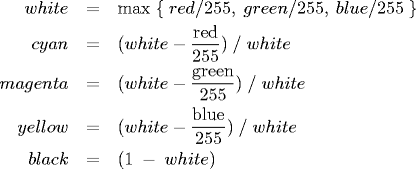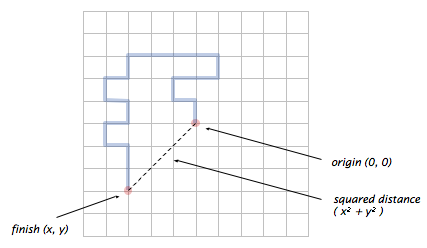CIS 110 Summer 2013 - Introduction to Computer Programming
Homework 1: Conditionals and Loops
Goals
The goal of this assignment is to write five short Java programs to gain practice with expressions, loops and conditionals (Sections 1.2 and 1.3 of the textbook).Part I: Boolean and integer variables
- Write a program Ordered.java that reads in three integer command-line arguments, x, y, and z.
- Define a boolean variable isOrdered whose value is true if the three values are either in strictly ascending order (x < y < z) or in strictly descending order (x > y > z), and false otherwise.
- Print out the variable isOrdered using System.out.println(isOrdered).
- Be sure to include a file header!
Sample Interactions:
% java Ordered 10 17 49 true % java Ordered 49 17 10 true % java Ordered 10 49 17 false
Part II: Type conversion and Conditionals
Background: Several different formats are used to represent color. For example, the primary format for LCD displays, digital cameras, and web pages, known as the RGB format, specifies the level of red (R), green (G), and blue (B) on an integer scale from 0 to 255. The primary format for publishing books and magazines, known as the CMYK format, specifies the level of cyan (C), magenta (M), yellow (Y), and black (K) on a real scale from 0.0 to 1.0.- Write a program RGBtoCMYK.java that converts RGB to CMYK. Read three integers red, green, and blue (between 0 and 255, inclusive) from the command line.
- Print the equivalent CMYK values using these formulas:

- Hint. Math.max(x, y) returns the maximum of x and y.
Sample Interaction:
% java RGBtoCMYK 75 0 130 // indigo cyan = 0.423076923076923 magenta = 1.0 yellow = 0.0 black = 0.4901960784313726
- Note: If all three red, green, and blue values are 0, the resulting color is black, so you should output 0.0, 0.0, 0.0 and 1.0 for the cyan, magenta, yellow and black values, respectively.
- Be sure to include a file header.
Part III: Euclid's Algorithm
- Write a program GCD.java that takes two positive (non-zero) integers a and b as command-line arguments.
- Use a while loop to compute the greatest common divisor (GCD) of a
and b via Euclid's Algorithm. (The GCD of two positive integers
is the largest integer that evenly divides both of them.)
- Euclid's algorithm works by repeated subtraction: if b is larger than a, subtract a from b.
- Otherwise subtract b from a.
- Repeat this process until one of the two numbers is zero; the other number is the GCD.
- The key observation is that, if an integer d evenly divides both a and b, it must also evenly divide a - b. Note that this formulation of Euclid's algorithm differs slightly from the version in exercise 1.3.28 in the book.
- Be sure to include a file header.
Sample Interactions:
% java GCD 3 5 The GCD of 3 and 5 is 1. % java GCD 8 12 The GCD of 8 and 12 is 4. % java GCD 7 14 The GCD of 7 and 14 is 7. % java GCD 546 822 The GCD of 546 and 822 is 6.
Part IV: Checkerboard
- Write a program Checkerboard.java that takes an integer command-line argument N.
- Use two nested for loops to print an N-by-N "checkerboard" pattern like the one below: a total of N2 asterisks, where each row has 2N characters (alternating between asterisks and spaces).
- Each line should start and end with the | character (Shift-\). These are in addition to the 2N characters in the step above.
- Be sure to include a file header.
Sample Interactions:
% java Checkerboard 4 % java Checkerboard 5 |* * * * | |* * * * * | | * * * *| | * * * * *| |* * * * | |* * * * * | | * * * *| | * * * * *| |* * * * * |

Part V: A drunkard's walk
Background: A drunkard begins walking aimlessly, starting at a lamp post. At each time step, the drunkard forgets where he or she is, and takes one step at random, either north, east, south, or west, with probability 25%. How far will the drunkard be from the lamp post after N steps?- Write a program RandomWalker.java that takes an integer command-line argument N.
- Simulate the motion of a random walker for N steps. After each step, print the location of the random walker, treating the lamp post as the origin (0, 0).
- Also, print the square of the final distance from the origin.
- Be sure to include a file header.
Sample Interactions:
% java RandomWalker 10 % java RandomWalker 20 (0, -1) (0, 1) (0, 0) (-1, 1) (0, 1) (-1, 2) (0, 2) (0, 2) (-1, 2) (1, 2) (-2, 2) (1, 3) (-2, 1) (0, 3) (-1, 1) (-1, 3) (-2, 1) (-2, 3) (-3, 1) (-3, 3) squared distance = 10 (-3, 2) (-4, 2) (-4, 1) (-3, 1) (-3, 0) (-4, 0) (-4, -1) (-3, -1) (-3, -2) (-3, -3) squared distance = 18
Part VI: A drunken throng
Background: Now consider a bar at closing time. Instead of a single drunkard, there are suddenly many staggering around. It's hard to predict where any single one will end up, but it's useful to know if any patterns emerge such as how far away they tend to be from the bar when they all vomit 30 minutes later. (Street cleaners find this sort of information useful.) The simplest way — and in many cases the only way — of detecting aggregate patterns in random processes is to simulate many individual cases and see what emerges.
- Write a program RandomWalkers.java that takes two integer command-line arguments N and T.
- In each of T independent experiments, simulate a random walk of N steps and compute the squared distance.
- Output the mean squared distance (the average of the T squared distances).
- Be sure to include a file header.
Sample Interactions:
% java RandomWalkers 100 10000 % java RandomWalkers 400 2000 mean squared distance = 101.446 mean squared distance = 383.12 % java RandomWalkers 100 10000 % java RandomWalkers 800 5000 mean squared distance = 99.1674 mean squared distance = 811.8264 % java RandomWalkers 200 1000 % java RandomWalkers 1600 100000 mean squared distance = 195.75 mean squared distance = 1600.13064
As N increases, we expect the random walker to end up further and further away from the origin. But how much further?
- Use RandomWalkers to formulate a hypothesis as to how the mean squared distance grows as a function of N.
- Use a variety of values for T (as shown above) for testing the program, but for this analysis, use T = 100,000 trials to get a sufficiently accurate estimate.
Remark: this process is a discrete version of a natural phenomenon
known
as Brownian
motion. It serves as a scientific model for an astonishing range
of physical processes from the dispersion of ink flowing in water, to
the formation of polymer chains in chemistry, to cascades of neurons
firing in the brain. It is named for the 19th century biologist
Robert Brown; the fact that Dr. Brown has no sense of direction is
completely coincidental.
If you're stuck: To get started, copy RandomWalker.java to a file RandomWalkers.java.
Now, think about what additional variables you need to maintain.
You certainly need to read in and store the command-line arguments N
and T.
In addition to the current location (x, y) of the random walker, you
need an accumulator variable, say totalSquaredDist, that stores the total
sum of squared distances so far.
Nest the loop inside an outer loop that repeats T times and add code
to update totalSquaredDist after each time through the outer loop.
Part VII: Submit
- Download readme_loops.txt, open it in DrJava, and answer the questions.
- Use the "Submission and Scores" link course sidebar to submit task hw01.
- Log in with your PennKey.
- Upload Ordered.java, RGBtoCMYK.java, GCD.java, Checkerboard.java, RandomWalker.java and RandomWalkers.java and readme_loops.txt using the provided form.
- Click "Submit" to submit your homework. Save the submission receipt as your proof of submission.
- Remember: Your file names should match the required exactly, file names including capitalization. Make sure you submit the .java files, NOT the .class files.